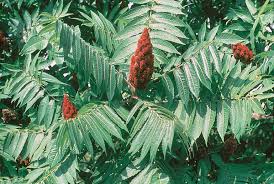QUANTITATIVE DETERMINATION OF THE SUM OF PHENOLIC COMPOUNDS IN FRUIT OF RHUS TYPHINA(L.)
Abstract
The genus Rhus of the Anacardiaceae family includes about 120–150 species of small trees, bushes, and lianas. The chemical composition of the sumac fluffy Rhus typhina (L.) is almost unknown. Previously, some phenolic compounds (rutin, quercetin, hyperoside, tannin, gallic acid) were identified in the fruits of the plant. To quantify the amount of phenolic compounds in the raw materials studied, a method based on the complexation reaction of phenolic compounds with a phosphomolybdic-tungsten reagent (Folin-Denis reagent) in an alkaline medium was chosen. The optimal conditions for the complexation reaction are selected: the ratio of the solution of gallic acid and Denis-Folin reagent is 0.06 mg / 1.6 ml, respectively. For the quantitative determination of the amount of phenolic compounds for the aqueous extraction of sumac fluffy must be added 1.1 ml of Denis-Folin reagent, to alcohol-water extraction – 1.2 ml of Folin-Denis reagent. The maximum value of optical density in aqueous and alcohol-aqueous extractions is observed at a wavelength of 720 nm. In alcohol-water extraction, more phenolic compounds (A = 0.8683) pass into the alcoholic water than to the aqueous one (A = 0.6346). The method used is valid and can be used for quantitative determination of the amount of phenolic compounds in fruits of sumac fluffy. To evaluate the linearity, the regression equation is calculated y = 941.67x + 0.0725 and the correlation coefficient r = 0.9895. The concentration of phenolic compounds in alcohol-water extraction was determined from the calibration graph. The average content of the sum of the phenolic compounds in terms of the gallic acid in the alcohol- water extraction was 10.04 ± 0.17%. The relative standard deviation (RSD) is 2.61%.
Downloads
Metrics
References
Rastitel'nyye resursy SSSR: Tsvetkovyye rasteniya, ikh khimicheskiy sostav, ispol'zovaniye; Semeystva Rutaceae – Elaegnaceae. [Plant resources of the USSR: Flowering plants, their chemical composition, use; Rutaceae families – Elaegnaceae].Leningrad, 1988, 357 p. (in Russ.).
FS 42-1965-83. List'ya sumakha dubil'nogo (Folia Rhus coriaria). [FS 42-1965-83. Tannery sumac leaves (Folia Rhus coriaria)].(in Russ.).
Mamatkulova N.M, Khidyrova N.K, Mamadrakhimov A.A, Shakhidoyatov Kh.M. Khimiya prirodnykh soyedineniy, 2014,no. 5,pp. 723–726.(in Russ.).
Il'ina I.G., Rudakova I.P., Samylina I.A. Farmatsiya, 2013,no. 8,pp. 3–7. (inRuss.).
de la Iglesia R., Milagro F.I., Campion J., Boque N., Martinez J.A. Bio-Factors,2010,vol. 36 (3),pp. 159–168, DOI: 10.1002/biof.79.
KotasM.E., Medzhitov R. Cell., 2015,vol. 160 (5),pp. 816–827, DOI: 10.1016/j.cell.2015.02.010.
Chillar R., Dhigra D. Fundamental and Clinical pharmacology,2013,vol. 27 (4),pp. 409–418, DOI: 10.1111/j.1472-8206.2012.01040.x.
Lu Y., Katakovsky M, Jiang F. European Journal of Pharmacology,2010,vol. 641 (2–3),pp. 102–107, DOI: 10.1016/j.ejphar.2010.05.043.
Verma S., Singh A., Mishra A.A. Environmental Toxicology and Pharmacology,2013,vol. 35 (3),pp. 473–485, DOI: 10.1016/j.etap.2013.02.011.
Xiao J., Ni X., Kai G., Chen X. Critical Reviews in Food Science and Nutrition,2013,vol. 53 (5),pp. 497–506, DOI: 10.1080/10408398.2010.548108.
Smit A. Farmatsiya, 2016,vol. 65,no. 8, pp. 53–56.(inRuss.).
Petrova A.A., Popov I.V. Chteniya molodykh uchenykh: materialy mezhdunarodnoy nauchno-prakticheskoy konfer-entsii. Seriya «Nauchnyy vestnik». [Readings of young scientists: materials of the international scientific-practical con-ference. Series "Scientific Bulletin"]. 2016, pp. 126–128. (inRuss.).
Wei Z.P., LiuJ.J.ProtectionForest Science and Technology,2001,vol. 3,p. 81.
Korul'kin D.Yu., Abilov Zh.A., Muzychkina R.A., Tolstikov G.A. Prirodnyye flavonoidy. [Natural flavo-noids].Novosibirsk, 2007, 229 p. (inRuss.).
Wang S., Zhu F. Food Chemistry,2017,vol. 237,pp. 431–443, DOI: 10.1016/j.foodchem.2017.05.111.
Kossah R., Zhang H., Chen W. Food Control,2011,vol. 22 (1),pp. 128–132, DOI: 10.1016/j.foodcont.2010.06.002.
Olchowik E., Sciepuk A., Mavlyanov S., Abdullajanova N., Zamaraeva M. Biomedicine and Preventive Nutri-tion,2012,vol. 2,no. 2,pp. 99–105, DOI: 10.1016/j.bionut.2011.06.008.
Goncharova V.Ye., Popova O.I., Leonova V.N. Belikovskiye chteniya: materialy VI Vserossiyskoy nauchno-prakticheskoy konferentsii. [Belikovsky readings: proceedings of the VIth All-Russian Scientific-Practical Conference]. Pyatigorsk, 2018,pp. 145–150. (inRuss.).
Kalinin A.M., Antonova N.P., Bokovikova T.N., Prokhvatilova S.S., Shefer Ye.P. Khimiko-farmatsevticheskiy zhurnal, 2017, vol. 51, no. 12, pp. 17–20, DOI: 10.30906/0023-1134-2017-51-12-17-20 (inRuss.).
Gritsenko A.I., Gubanova L.B., Popova O.I. Sovremennyye problemy nauki i obrazovaniya, 2015, no. 1 (1), URL: http://science-education.ru/ru/article/view?id=18495 (in Russ.).
Marakhova A.I., Stanishevskiy YA.M., Potapov V.I., Sorokina A.A. Razrabotka i registratsiya lekarstvennykh sredstv, 2014,no. 8,pp. 138–141. (inRuss.).
Trineyeva O.V., Slivkin A.I. Farmatsiya, 2014, no. 1, pp. 16–19. (inRuss.).
Popov I.V., Chumakova V.V., Popova O.I., Leonova V.N. Razrabotka, issledovaniye i marketing novoy farmatsevtich-eskoy produktsii: sbornik nauchnykh trudov [Development, research and marketing of new pharmaceutical products: a collection of scientific papers]. 2017, pp. 68–71. (inRuss.).
Popov I.V., Andreyeva I.N., Gavrilin M.V. Khimiko-farmatsevticheskiy zhurnal, 2003, vol. 37, no. 7, pp. 24–26. (in-Russ.).
KhasnabisJ., RaiC., RoyA. JournalofChemical and Pharmaceutical Research,2015,vol. 7 (6),pp. 238–241.
Gosudarstvennaya farmakopeya RF XIII izdaniya[State Pharmacopoeia of the Russian Federation XIII edition]. Mos-cow, 2015,vol. 2,URL: http://193.232.7.120/feml/clinical_ref/pharmacopoea_2/HTML#408(in Russ.).
AOAC Peer Verified methods Program, Manual on policies and procedures, Arlington, VA, 1993. Development Pharmaceutics and Process Validation: Directive 75/318/EEC - 1998.


This work is licensed under a Creative Commons Attribution 4.0 International License.
The authors, which are published in this journal, agree to the following conditions:
1. Authors retain the copyright to the work and transfer to the journal the right of the first publication along with the work, at the same time licensing it under the terms of the Creative Commons Attribution License, which allows others to distribute this work with the obligatory indication of the authorship of this work and a link to the original publication in this journal .
2. The authors retain the right to enter into separate, additional contractual agreements for the non-exclusive distribution of the version of the work published by this journal (for example, to place it in the university depository or to publish it in a book), with reference to the original publication in this journal.
3. Authors are allowed to post their work on the Internet (for example, in a university repository or on their personal website) before and during the review process of this journal, as this may lead to a productive discussion, as well as more links to this published work.











